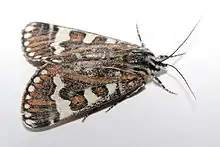Pasture day moth
The pasture day moth, Apina callisto, is a species in the moth family Noctuidae which is active during the day, as its common name implies, making it unlike most other noctuid species. It is found in most southern areas of Australia, ranging from lower Queensland to Tasmania. The species was first described by George French Angas in 1847. It is the only species in the monotypic genus Apina, erected by Francis Walker in 1855.[1][2][3]
| Pasture day moth | |
|---|---|
 | |
| Apina callisto | |
| Scientific classification | |
| Kingdom: | Animalia |
| Phylum: | Arthropoda |
| Class: | Insecta |
| Order: | Lepidoptera |
| Superfamily: | Noctuoidea |
| Family: | Noctuidae |
| Subfamily: | Agaristinae |
| Genus: | Apina Walker, 1855 |
| Species: | A. callisto |
| Binomial name | |
| Apina callisto Angas, 1847 | |
| Synonyms | |
|
Generic
Specific
| |
The pasture day moth lays its eggs in pastures, and they hatch after heavy rains in early spring. When the larvae are fully grown, measuring about 60 mm (2.4 in), they burrow down before becoming pupae. They have striking coloration; two yellow stripes run down their mottled-black back, interspersed with blue spots. Their bodies are covered with white spines. They feed on various broad leaved plants (see list below).
The adult moth's wings are black with cream and chestnut markings, with a wingspan of approximately 50 mm (2.0 in). Its thorax is black and the abdomen is orange, ringed with black.

Recorded food plants

References
- Beccaloni, G.; Scoble, M.; Kitching, I.; Simonsen, T.; Robinson, G.; Pitkin, B.; Hine, A.; Lyal, C., eds. (2003). "Pasture day moth". The Global Lepidoptera Names Index. Natural History Museum. Retrieved 17 November 2020.
- Savela, Markku (August 22, 2019). "Apina Walker, 1855". Lepidoptera and Some Other Life Forms. Retrieved 17 November 2020.
- Pitkin, Brian & Jenkins, Paul (5 November 2004). "Apina Walker, 1855". Butterflies and Moths of the World. Natural History Museum, London. Retrieved 17 November 2020.
| Wikimedia Commons has media related to Apina callisto. |
External links
- "Apina callisto (pasture day moth)". Ecowatch. Archived 29 September 2004.
- "Pasture day moth Apina callisto". PestWeb. Archived 11 October 2004.
- Herbison-Evans, Don & Crossley, Stella (13 June 2020). "Apina callisto (Angas, 1847) Pasture Day Moth". Australian Caterpillars and their Butterflies and Moths. Retrieved 17 November 2020.